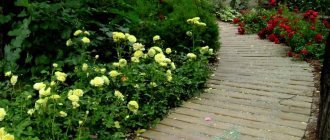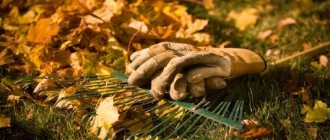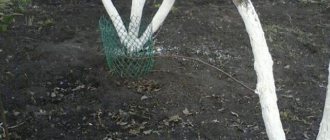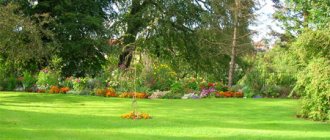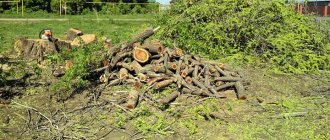Lawn care in the fall and preparation for winter include several simple procedures: timely mowing, aeration and fertilization. We’ll talk more about what else is important to know about pre-winter “lawn” work in our article.
A well-groomed and healthy lawn is a decoration for a suburban area. In order not to think about how to restore a frozen lawn at the beginning of the next season, take care of your garden lawn now. We tell you how to care for your lawn in the fall in order to properly prepare it for winter.
When to stop watering
In most regions of Russia, the arrival of autumn means an increase in precipitation. Accordingly, the lawn receives much more moisture than in the summer months, when it had to be watered regularly. For this reason, it is necessary to gradually stop watering, otherwise excess moisture can lead to puddles forming on the surface, which can lead to rotting.
But what to do if the autumn turns out to be dry? In this situation, you can adhere to the standard scheme, which is to reduce the frequency of watering in September (once every 5-7 days), and in early October you need to stop watering the lawn altogether.
In autumn, the air temperature drops, so the water for irrigation itself should be slightly warmed up.
The need for feeding
Fertilizing with mineral fertilizers will ensure stable plant growth in the spring. Gardeners have different opinions regarding the composition of fertilizers. Some believe that in the autumn, plants especially need phosphorus and potassium - microelements that stimulate root formation. Therefore, the main emphasis when fertilizing the lawn should be on them. Fertilizing with nitrogen, which is a stimulator of green mass growth, should be limited.
Other gardeners argue that it is impossible to maintain a decorative lawn throughout the season without fertilizing with nitrogen. Lawn grasses continue to increase their plant mass even as temperatures drop in the fall months. Nitrogen, without reducing the winter hardiness of plants, makes the color of greenery more saturated in the autumn months.
Last haircut
Another equally important question is when is the last time to mow the lawn before winter? If in summer the lawn has to be mowed approximately 1-2 times a week, then with the arrival of autumn the intensity decreases - to 1-2 times a month. Keep in mind that cutting in the autumn is absolutely necessary, otherwise the tall grass will fall down with the arrival of frost, which will prevent the growth of new shoots.
The last cutting should be done two weeks before the expected date of the first frost. Accordingly, this date will differ depending on the specific region. In the south this may be the end of October, and in the northern regions - early or mid-September.
It is believed that the height of the grass when the lawn goes dormant should be about 6-8 cm. Therefore, the last time of the year the grass should be cut to 4 cm, because in the fall its growth rate slows down and it is unlikely to grow more than 8 cm. This length is considered optimal for wintering, because in the spring old blades of grass will not interfere with the growth of new grass. And, of course, all mowed vegetation must be removed and not left on the site.
Autumn mowing height
The height of the last mowing before winter depends on whether it is possible to constantly pay attention to the lawn or whether it is located in a summer cottage where people come occasionally. Based on this, two options are possible:
- If in the last month before the onset of significant cold weather there is no opportunity to mow the area, then the last time the grass is mowed short, so that before winter the growth is no more than 10-12 cm.
- If the site is located at home or in an area of constant accessibility, then before the temperature drops to 10°C, mowing is done to a standard height of 10-12 cm. After the first frosts and daytime thawing, each time you need to mow 1-2 cm lower than the previous one. Mowing stops completely only after reaching -3-5°C.
Cleaning Rules
Cleaning isn't just about removing all the grass clippings and debris from the area. It is necessary to additionally scarify the lawn in the fall (cutting) or verticulate it (combing). This procedure is the removal of turf felt, i.e. withering vegetation.
You should not refuse to clean the lawn, because it promotes a greater supply of oxygen to the root system of plants, and also increases the chances of a successful wintering.
Types of lawns and care features
In addition to the classic English lawn, formed by plants of one type, there are so-called “meadow”, “Moorish”, “sports”, “parterre” types of lawns. They differ in a certain set of plants and the height of the grass cover.
Meadow lawn is closest to a natural meadow, so it is cut to a high height (8-10 cm) and this is done after perennial plants bloom and before another plant variety begins to bloom. The Moorish lawn requires virtually no cutting, or is cut by hand so as not to damage flowering perennial plants. Lawn care in the fall consists of removing debris, fertilizing, watering and mulching. Sports and parterre lawns are mowed shorter, so the last autumn mowing for them may be later.
When to fertilize your lawn in the fall?
Fertilizing your lawn in the fall is no less important than mowing it. Fertilizing can be done manually (if the area is small), or using irrigation systems or specialized devices.
The fertilizer itself must necessarily contain potassium and phosphorus, which help strengthen the root system of plants. They stop fertilizing with nitrogen in the fall because it helps accelerate grass growth, which, for obvious reasons, we don’t need at all. By the way, this issue causes a lot of controversy, and some believe that nitrogen fertilizers should be used, because in the spring it will produce results - the lawn will begin to turn green earlier than expected. But no one is stopping you from using nitrogen next year, i.e. in the spring.
Potassium-phosphorus fertilizers are best applied in mid-September, when the air temperature is still above +10 degrees Celsius. Here are a few simple rules to follow when feeding:
- Fertilizers should be applied during irrigation. For liquid products, the best solution is to use it while irrigating the lawn. Fertilizers in granular form also need water, so you should water your lawn after applying it.
- It is best to apply fertilizers after all preparatory procedures, i.e. after cutting, removal of turf felt and aeration.
- The soil should be slightly damp and the grass should be dry. You need to feed in cloudy, dry weather, about 3-4 days after mowing the grass.
The use of potassium is mandatory because it increases plant resistance to diseases. Potassium sulfate (20-30 g per 1 m2) and potassium salt (30-40 g per 1 m2) are suitable for feeding. In general, there are special lawn fertilizers on sale that need to be applied in the fall. They have the most balanced composition, and on the packaging you can find all the necessary information about the method of application, etc.
Winter care tips
But preparing the site for winter is not all there is to worry about. To ensure that your lawn pleases you with greenery next year, you should take care of this during the winter cold. Otherwise, in the spring, instead of a neat lawn, you will have an area with sparsely growing grass .
Firstly, in winter you should not walk through the area where lawn grass is planted. At least, experts do not recommend doing this until the layer of snow becomes 15-20 centimeters thick.
Secondly, you cannot store a lot of snow from neighboring areas on the area where lawn grass grows. This additional stress can damage the grass. In this case, in the spring you will have to spend additional money on buying seeds and wait a long time for the new grass to catch up with the old one.
In addition, you need to monitor the formation of an ice crust on the area. Very often, especially in the southern regions, after a thaw a layer of ice forms on the surface. If this happens to an area allocated for a lawn, then you need to get rid of the crust quickly. This layer of ice will prevent air from reaching the grass. For the same reason, it is not recommended to fill the skating rink in areas where lawn grass grows.
Particular attention should be paid to lawn grass in the spring. The plants have just begun to recover from the winter cold and are very weak, so during this period they need support. First of all, fertilizers are applied to the soil. After this, after the snow has completely melted, you need to thoroughly comb the grass. This will provide access to fresh air.
Aeration
Aeration should be carried out before fertilizing. It is necessary to provide plant roots with oxygen, as well as for the free flow of moisture into the lower layers of the soil.
Aeration is best done in dry weather, using ordinary garden forks - just pierce the soil and slightly lift the turf layer, slightly tilting it towards you.
There is no need to pierce deeply - 20 cm is enough. The distance between the punctures is from 20 to 30 cm. Keep in mind that after aeration, the lawn surface must be allowed to recover, so do not walk on it for two or three days.
Last time to mow the lawn
In summer, the grass near the house is cut every 7-10 days, as it grows quickly and intensively. In autumn, the procedure is done less frequently. The last cutting is carried out in October before the first night frosts. The air temperature should remain 10-12*C. If you don’t cut the grass before winter, it will fall down with the first frost, begin to rot, and become an obstacle to the growth of new plants in the spring.
You may be interested in:
The first lawn mowing after planting: when to do it Caring for lawn grass is an integral measure for maintaining the garden area in order. To…Read more…
You may need to mow your lawn more than once before the cold weather starts. When the weather is warm in September and it rains periodically, the grass quickly grows back. If in October you don’t have time to trim before frost, then he may grab uncut greenery, it will fall down and begin to rot.
Each region has its own deadline for the last mowing of the lawn:
- north of the country - September 15-25;
- the central part of the Russian Federation - October 1-10;
- southern regions of Russia - October 15-25.
Important!
Mowing later in November will not allow the plants to recover before frost or the first snow; the grass may freeze.
Mulching
Mulching allows you to maintain a sufficient level of moisture in the soil, as well as protect the surface from exposure to negative temperatures. Mulching can be done using prepared garden soil or a mixture of sand, peat and soil.
This procedure must be carried out after cutting and aeration. Can be carried out in conjunction with the application of fertilizers. The mulch mixture is poured to a height of up to 1.5 cm, and the remains from the grass are swept away with a regular broom.
Cleaning and combing
After mowing, the lawn is thoroughly cleaned of mown grass and fallen leaves. If this is not done, the grass cover will lose its attractiveness under a layer of uncollected plant debris. It will rain, high humidity will cause diseases of the root system.
It is better to clean every week using a fan rake. Additional benefits of using them are that they loosen the soil and lift the plants. You can work with leaf raking models with plastic and metal flat teeth. They do not injure the stems and root system.
You should comb out thoroughly at different angles, but try not to damage the roots. This procedure will allow new shoots to develop better next year, resulting in a denser lawn. At the same time you need to fight the moss. If it is not possible to remove it mechanically, they resort to herbicides that contain iron sulfates, ammonium sulfates and sand without lime.
Sowing a lawn before winter
Sowing a lawn in the fall is preferable to spring. This is explained by the fact that the ambient temperature is still quite comfortable, and the soil has optimal moisture.
First you need to properly prepare the area:
- All weeds and debris are removed.
- The surface of the area is leveled.
- Drainage using gravel or sand.
- Digging the soil - after this procedure you need to leave the soil for 2-3 weeks.
- Laying plant soil that will provide the seeds with the necessary substances.
- Application of mineral fertilizers.
Sowing seeds should be done in calm weather. Next, they need to be protected by sprinkling with peat, and the area should be leveled with a lawn roller. If there is no rain, then watering can be done.
The timing of sowing depends on specific climatic conditions. You can begin work at the end of August, and the sowing itself should be carried out approximately 40 days before the expected frost. If the area is flat, then we can sow “under the snow” (in this case there is no need to water). Seeds are sown right before the first snowfalls, in slightly frozen soil.
Lawn scarification technology
Scarification is the process of combing dry grass and hay from the roots of young lawn grass. This procedure ensures good access of oxygen to the grass roots, making the lawn neater and more beautiful. A layer of hay may be present on the lawn for a natural mulch effect. However, when the height of the hay exceeds five millimeters, the grass begins to wither and the lawn does not look very well-groomed. In addition to scarification, it is necessary to carry out such procedures as aeration and verticulation of the lawn. They are needed for good air permeability of the turf.
The scarification procedure can be carried out both in spring and autumn. To do this, you need to choose the evening of a sunny and dry day. There should be no precipitation or natural dew on the grass. There is also no need to water the lawn before scarification. To perform such work on the lawn, you can purchase a special scarifier or use a handy rake.
It is simply necessary to prepare for scarification! Twenty days before the procedure, the lawn should be treated with special herbicides. If you don't have weeds in your lawn, you won't need to treat it. Fourteen days before scarification, the lawn grass should be mowed to five centimeters in height of the lawn. Mosses also need to be treated with herbicides if they are present on the lawn. This can be done a week before treating the lawn.
The first stage of the procedure is very similar to mowing grass. It is necessary to move from the longest marking of the lawn, along it to the very end, and then in parallel. Debris is collected in the lawnmower compartment along with grass clippings. You can also remove grass debris with a lawn rake. Then you need to carry out the second stage of processing. It involves moving the scarifier diagonally at an angle of forty-five degrees. You need to move across and along. The blades can be cut into the ground to a depth of five millimeters. If everything is done correctly, the lawn will not suffer any damage.
In the spring, during this procedure, you can sow lawn grass seeds to prevent the growth of weeds and restore the beauty of the lawn.
Scarification is an important procedure that every lawn needs in the fall. The procedure must be performed carefully, prepare the lawn in advance and perform all movements in accordance with the technique. After scarification, the lawn will be healthy, beautiful and well-groomed.
MOST READ FROM PARTNERS
Is sanding necessary?
Sanding can be carried out until the beginning of October. The area is pre-fed, watered and after a few days the remaining moisture is removed from the surface. Next, all debris is removed from the coating.
Depending on the type of soil, a mixture for sanding is prepared:
- Four parts of soil, three parts of peat and sand (sifted) - for normal soil type.
- Four parts each of soil and peat, mixed with two parts sand - for sandy soils.
- Five parts of sand are mixed with three parts of soil and two parts of peat - for clay.
Standard consumption is 3 kilograms of mixture per square meter of area. It is important to distribute the mixture evenly using a broom or brush. If the soil is very loose, sanding is not carried out.
In winter, when snow falls, you should try to distribute it evenly over the lawn. If this is not possible and there will be piles of snow on the lawn, then in the spring, when they begin to thaw, they should be scattered over the entire surface. If this is not done, then the grass will rot under the pile of snow.
Mr. Summer resident recommends: two tips
- A few words about the fight against moss; it grows everywhere, especially loves semi-shaded areas. Sphagnum must be removed as soon as small pockets appear, otherwise the moss will quickly spread throughout the lawn. First of all, we water the lawn with Florovit and dilute it according to the instructions. There are packages marked “M”, where the concentration is higher. This is iron sulfate - iron sulfate, from which the moss darkens, then disappears from the area completely. With regular aeration, moss plants are formed less frequently.
- What to do with the leaves? From my own experience I was convinced that it is still better to collect the foliage. I do this myself after the first snow, early in the morning, while the soil is frozen. I sweep the leaves to the edge of the lawn and then collect them from the path into trash bags. It takes much less time to remove leaves in the fall than in the spring. The lawn thaws more evenly, and rotted dark spots often appear under layers of frozen foliage. When the leaves are single, the last ones, they are not so terrible for the green carpet.
Types of lawn
Everyone calls a beautiful and well-groomed lawn in front of the house a lawn. Neatly trimmed grass looks beautiful and creates a cozy place to relax. But not everyone knows that the lawn has several varieties, and each of them requires its own care.
Read also: What happens if you eat false honey mushrooms
Landscape designers distinguish the following main types of lawn:
- Parterre is the most elite and high-maintenance variety. Such a lawn does not tolerate trampling, grows thickly and creates the most beautiful green carpet;
- The common variety is the most commonly found lawn variety. You can walk on such a green lawn; he is less demanding and easily endures all adversities. But the aesthetic side is much inferior to its counterpart;
- Moorish lawn. On such a lawn, which is most often found around artificial reservoirs, in addition to grass, various wildflowers can grow. You can walk on such a lawn, but it is better not to do so, so as not to spoil the aesthetics of the natural meadow;
- Sports turf – its functionality is clear from the name. You can run and play sports in such a clearing without fear of harming your appearance. But such endurance is achieved through strict adherence to growing technologies, which are quite difficult to implement.
There are other subtypes of lawns , but they are all similar in their characteristics and methods of care to the above options.
Lawn in landscape design
Mowing is one of the main types of lawn care. It begins in mid-May or earlier, depending on natural conditions. The main characteristic that determines the start of spring mowing is the length of the grass. When this indicator reaches 10 centimeters, it is recommended to carry out the first haircut. The goal of the procedure is to give the plants an optimal length of 4-5 centimeters. Shorter grass quickly withers due to drying out of the soil and can die completely, especially during the hot period of the year. Plants of greater length do not hold the required shape and droop. Such a lawn looks sloppy, untidy and is not a decoration for the home. To maintain the lawn in proper shape, it is recommended to trim it once every one to two weeks. The length of the period mainly depends on the intensity of plant growth, which, in turn, depends on the amount of moisture (watering, precipitation) and fertilizing.
Along with lawns, lawn care tools came to our country. And one of the most popular of them is lawn mowers.
What types of these units are not found in modern specialized companies. By purchasing one of these, you can give your lawn vegetation the perfect trim. Even if you come to the site only for the weekend, using high-quality mowers, it will not be difficult to maintain your bright green meadow in perfect condition.
How to apply fertilizers correctly
Fertilizing the surface in the fall must be done correctly. This will ensure that the desired result is obtained; the plants and their root system will not be injured.
- Before fertilizing, the soil must be well watered.
- Wait a day to absorb moisture.
- It is better to use special equipment to feed plants. This prevents damage to the green surface. A spreader is used to fertilize the lawn. He sells it in a specialized store, where he sells the fertilizers themselves.
- After 1-2 days, the lawn should be watered abundantly again. This will ensure complete absorption of the compounds used into the soil.
Application of nitrogen fertilizers
Low concentration nitrogen fertilizers are allowed for feeding the lawn in early autumn. Thanks to the products, the color of the grass improves. Plant growth is noticeably stimulated. This will bring the greatest benefit to grass weakened by summer drought and high temperatures. Nitrogen compounds are introduced strictly in the required concentration. Its increase leads to active plant growth, and this is undesirable on the eve of cold weather.
Application of phosphorus and potassium fertilizers
Phosphorus compounds must be used to feed grass in the fall. They effectively strengthen the root system and promote the growth of shoots on the sides. More often, gardeners prefer to fertilize areas with superphosphates. During this period, potassium fertilizers can also be applied to the soil. They are necessary to increase the stress resistance of plants to diseases. Potassium helps roots better absorb nutrients and strengthens them. This will help the lawn survive the winter well. Potassium sulfate is used for fertilizer. Wood ash, rich in potassium, is also used.
MOST READ FROM PARTNERS
Instead of several products, it is better to purchase one concentrated fertilizer that contains phosphorus and potassium. This balanced mixture is sold in stores with clear instructions for use.


